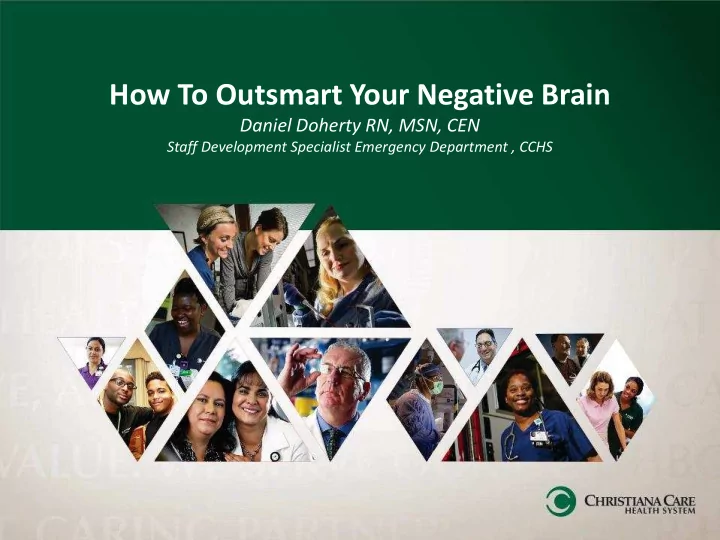

How To Outsmart Your Negative Brain Daniel Doherty RN, MSN, CEN Staff Development Specialist Emergency Department , CCHS
Disclosure Statement Presenter discloses no conflict of interest relative to this educational activity
Learning objectives • Identify how stress can cause the brain’s negative bias • Discover the negative outcomes of utilizing “reactive” coping strategies • Develop initial strategies to overcome the stressful effects of working in nursing • Apply strategies to separate work from home • Modify their thoughts process to outsmart their negative brain
Christiana Health Care Systems • 150+ Patient and Family Advisers • Primary Care Office Visits: 227,295 • Home Health Care Visits: 308,096 • 21st in U.S. Admissions: 53,072 • 29th in U.S. Surgeries: 38,712 • 21st in U.S. ED Visits: 187,317 • 32nd in U.S. Births: 6,469 .
The Catalyst
Cost to The Brain • Burnout • Compassion fatigue • Vicarious trauma
Burnout •
Compassion Fatigue
Vicarious Trauma • Not PTSD Affects not just us
The Big Issue • Lack of control and uncertainty • Do not know the beginning or often do not see the end (fragmented care)
What Happened Here?
Our 1 st Ineffective Strategy Withdrawal/Detach – Brain upset – No one will listen • Where do your stories go • Sliming colleagues
Answer: It’s not my journey
Our Confusion • Compassion • Seeing someone suffering and wanting to help • Empathy • Seeing someone suffering, taking on part of that suffering and wanting to help
Our 2 nd Favorite Ineffective Strategy What do you do in your free time? Idle brain/negative brain 12 minutes Missed opportunity
Effective Strategies • Tracking & monitoring all the external trauma exposure you are unconsciously absorbing • Use low impact debriefing (give warning) • Practice engaging with others--try to refocus and also monitor where your thoughts wander off to (spend more than 12 min) • Trick the brain into having fun • Try to keep in mind the definition of compassion • It’s not my journey • Don’t veg out but if you do recognize the negative thoughts
Signs/Symptoms Physical Psychological Exhaustion (tired vs. depleted) Exhaustion Insomnia Distancing Headache Reduced sympathy & empathy Susceptibility to illness Cynicism & embitterment Resentment Anxiety/irrational fears Depersonalization Intrusive images Loss of hope Difficulty separating work from personal life Failure to nurture and develop non-work related aspects Behavioral Drugs & alcohol Absenteeism/presenteeism Anger/irritability Exaggerated sense of responsibility (I can’t let people down, I can’t leave, people are counting on me) Avoidance behaviors Impaired decision making Forgetfulness Interpersonal relationships Negative self- image (feeling unskilled at this job, whether you are good at this job)
• Feeling depleted • Negative self image • Intrusive images/thoughts • Difficulty separating work from personal life
How Was Your day? 147 83 49 20 60 17 19 24 19 14 0
Effective Strategies • Giving your compassionate voice some air time • Have a symbolic transition ritual that you are no longer a nurse • Don’t allow the negative/dead people into your home • Do something selfish for your self • As you drive home remind yourself of three things you did to make someone feel better • Take 20 seconds to let that positive experience register in your brain
Happy Hormone-Dopamine 50%/10%/40%
Happy Hormone-Serotonin
The Problem Adrenaline and Cortisol (Half-life)
The Brain I think Brain wants here to know 2 things I think here I feel here Limbic System want to know 3 things
Mindfulness Meditation 5 things see, hear & feel Breath in & out 30 seconds
Effective Strategies • 5 thing you see, hear feel • Breath in and out for 30 seconds • Be compliant vs. non-compliant with your self-care • 95% of our reactions are automatic (don’t always act on what the limbic system says; listen a bit more to the pre-frontal lobe professor...no one is wanting to eat you • Be like Mandy---play a lot! • Dopamine (something to look forward to every 8 weeks, accomplish a goal), oxytocin (connect with people, touch someone) and give someone some serotonin
Questions? ddoherty@christianacare.org
Reference Bakker, A. B., Killmer, C. H., Siegrist, J., & Schaufeli, W. B. (2000). Effort-reward imbalance and burnout among nurses. Journal of Advanced Nursing, 31(4), 884 – 891. Retrieved from https://www.researchgate.net/publication/12556406_Effort- reward_imbalance_and_burnout_among_nurses Beck, C. T. (2011). Secondary traumatic stress in nurses: A systematic review. Archives of Psychiatric Nursing, 25(1). doi:10.1016/j.apnu.2010.05.005 Benoit, L. G, Veach, P. M., & LeRoy, B. S. (2007). When you care enough to do your very best: Genetic counselor experiences of compassion fatigue. Journal of Genetic Counseling, 16(3), 299 – 312. doi:10.1007/s10897-006-9072-1 Bergman, C. L. (2012). Emergency nurses’ perceived barriers to demonstrating caring when managing adult patients’ pain. Journal of Emergency Nursing, 38(3), 218– 225. doi:10.1016/j.jen.2010.09.017 Bober, T., & Regehr, C. (2005). Strategies for reducing secondary or vicarious trauma: Do they work? Brief Treatment and Crisis Intervention, 6(1), 1 – 9. doi:10.1093/brief-treatment/mhj001 Bradbury-Jones, C., & Tranter, S. (2008). Inconsistent use of the critical incident technique in nursing research. Journal of Advanced Nursing, 64(4), 399 – 407. doi:10.1111/j.1365- 2648.2008.04811.x
Reference Bradbury-Jones, C., & Tranter, S. (2008). Inconsistent use of the critical incident technique in nursing research. Journal of Advanced Nursing, 64(4), 399 – 407. doi:10.1111/j.1365- 2648.2008.04811.x Epstein, R. (2011). Fight the frazzled mind. Scientific American Mind,22(4), 29-35. Retrieved from http://drrobertepstein.com/downloads/Epstein-Fight_the_Frazzled_Mind- SCIENTIFIC_AMERICAN_MIND-Sept_Oct_2011-pp30-35.pdf?lbisphpreq=1 Hooper, C., Craig, J., Janvrin, D. R., Wetsel, M. A., & Reimels, E. (2010). Compassion satisfaction, burnout, and compassion fatigue among emergency nurses compared with nurses in other selected inpatient specialties. Journal of Emergency Nursing, 36(5), 420 – 427. doi:10.1016/j.jen.2009.11.027 Kerasiotis, B., & Motta, R. W. (2004). Assessment of PSTD symptoms in emergency room, intensive care unit, and general floor nurses. International Journal of Emergency Mental Health, 6(3), 121 – 133. Mathieu, F. (2012). The compassion fatigue workbook: Creative tools for transforming compassion fatigue and vicarious traumatization. New York, NY: Routledge. http://www. ProQOL.com
Recommend
More recommend